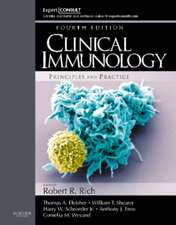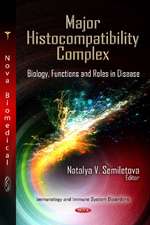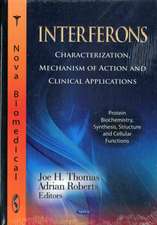The Development of Immunologic Competence
Autor Domenico Ribattien Limba Engleză Hardback – 9 mar 2016
Other themes explored in this book include discoveries about the role of the thymus of the Bursa of Fabricius in the development of immunologic competence, and observations on the changes in the lymphoid organs after bursectomy and thymectomy in chickens. Readers will discover how the bursa provides a unique microenvironment for the proliferation and differentiation of B cells, while thymectomized and irradiated animals were deficient in lymphocytes that mediated inflammatory responses, as assessed by skin graft rejection, delayed-type hypersensitivity, and graft versus host reaction.
A clear perspective for understanding several diseases and also the entire lymphoid system emerges through the experiments and extensive histopathological studies of patients with primary immunodeficiency diseases that are described in these chapters.
Researchers in the life sciences, in biomedicine and the history of medicine will all find something of value in this highly engaging work. It will also appeal to those with an interest in public health and neurobiology.
| Toate formatele și edițiile | Preț | Express |
|---|---|---|
| Paperback (1) | 642.31 lei 38-45 zile | |
| Springer International Publishing – 7 apr 2018 | 642.31 lei 38-45 zile | |
| Hardback (1) | 710.06 lei 6-8 săpt. | |
| Springer International Publishing – 9 mar 2016 | 710.06 lei 6-8 săpt. |
Preț: 710.06 lei
Preț vechi: 747.43 lei
-5% Nou
Puncte Express: 1065
Preț estimativ în valută:
135.87€ • 145.29$ • 113.29£
135.87€ • 145.29$ • 113.29£
Carte tipărită la comandă
Livrare economică 18 aprilie-02 mai
Preluare comenzi: 021 569.72.76
Specificații
ISBN-13: 9783319246611
ISBN-10: 3319246615
Pagini: 60
Ilustrații: VIII, 60 p. 29 illus., 22 illus. in color.
Dimensiuni: 155 x 235 x 6 mm
Greutate: 0.28 kg
Ediția:1st ed. 2015
Editura: Springer International Publishing
Colecția Springer
Locul publicării:Cham, Switzerland
ISBN-10: 3319246615
Pagini: 60
Ilustrații: VIII, 60 p. 29 illus., 22 illus. in color.
Dimensiuni: 155 x 235 x 6 mm
Greutate: 0.28 kg
Ediția:1st ed. 2015
Editura: Springer International Publishing
Colecția Springer
Locul publicării:Cham, Switzerland
Public țintă
ResearchCuprins
Preface.- Introduction.- Human hematopoietic development.-The Bursa of Fabricius.- The Thymus.- Clinical correlates.- References.- Index.
Textul de pe ultima copertă
This book traces significant aspects of the history of immunology, exploring the immune system and immunodeficiency. The author recounts human hematopoietic development, and how a distinction of the immune system into thymus-dependent and thymus-independent components has been demonstrated in different animal species, including amphibians, birds, and mammals.
Other themes explored in this book include discoveries about the role of the thymus of the Bursa of Fabricius in the development of immunologic competence, and observations on the changes in the lymphoid organs after bursectomy and thymectomy in chickens. Readers will discover how the bursa provides a unique microenvironment for the proliferation and differentiation of B cells, while thymectomized and irradiated animals were deficient in lymphocytes that mediated inflammatory responses, as assessed by skin graft rejection, delayed-type hypersensitivity, and graft versus host reaction.
A clear perspective for understanding several diseases and also the entire lymphoid system emerges through the experiments and extensive histopathological studies of patients with primary immunodeficiency diseases that are described in these chapters.
Researchers in the life sciences, in biomedicine and the history of medicine will all find something of value in this highly engaging work. It will also appeal to those with an interest in public health and neurobiology.
Other themes explored in this book include discoveries about the role of the thymus of the Bursa of Fabricius in the development of immunologic competence, and observations on the changes in the lymphoid organs after bursectomy and thymectomy in chickens. Readers will discover how the bursa provides a unique microenvironment for the proliferation and differentiation of B cells, while thymectomized and irradiated animals were deficient in lymphocytes that mediated inflammatory responses, as assessed by skin graft rejection, delayed-type hypersensitivity, and graft versus host reaction.
A clear perspective for understanding several diseases and also the entire lymphoid system emerges through the experiments and extensive histopathological studies of patients with primary immunodeficiency diseases that are described in these chapters.
Researchers in the life sciences, in biomedicine and the history of medicine will all find something of value in this highly engaging work. It will also appeal to those with an interest in public health and neurobiology.
Caracteristici
Builds understanding of the immune system and its evolution Provides a theoretical grounding in immunologic competence, for immunology and neurobiology Improves epistemological awareness of disciplinary problems through the history of immunology








